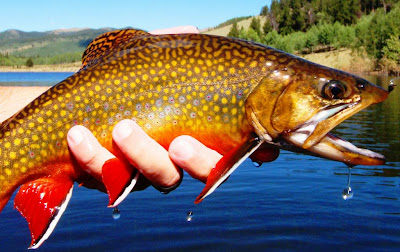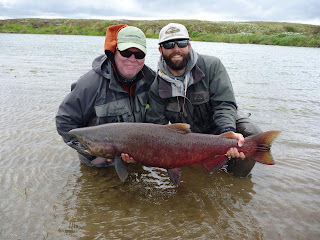 There is a lake in Colorado near where I fish each summer that is close to 11,000 feet in elevation. And in my opinion could be listed as one of the 5 most beautiful spots in Colorado. Maybe in the top 3! The spot is a great hiking destination. From the lake you can continue your hike by scaling through rocks on the almost nonexistent trail on the way to 13,000 plus feet. It also serves as a gateway to a summer skiing destination on the remaining glaciers. Of course, it also has some of the finest fly fishing you can imagine.
There is a lake in Colorado near where I fish each summer that is close to 11,000 feet in elevation. And in my opinion could be listed as one of the 5 most beautiful spots in Colorado. Maybe in the top 3! The spot is a great hiking destination. From the lake you can continue your hike by scaling through rocks on the almost nonexistent trail on the way to 13,000 plus feet. It also serves as a gateway to a summer skiing destination on the remaining glaciers. Of course, it also has some of the finest fly fishing you can imagine.I fly fish at this lake about 4-5 times each summer. It is a nice break from trudging through the willows, hi-lows and cow pies encountered on the way to begin fishing in the rivers. I fish this lake with my fishing partner, Jack. He is definitely the " Yoda" of our group. I am not the most proficient fly fisherman, but I do a pretty good job having fun landing these cutthroat.
The hike begins after a rocky and bumpy drive over rocks, through ditches, over bridges, through water and around downed trees. This brings you to about 10,250 ft. elevation. The perfect start to the fishing experience. The trail head begins in an open area. If you are lucky you will spot a moose, a deer, a mountain sheep and, of course, there is always the possibility of seeing a black bear. The hike starts with a short walk before you begin the trek up the rocky switchbacks for 3/4 miles- here you rejoice as you see the sign that reads "100 Yards to the Lake." It is there that the scene takes your breath away!!
THESE FISH ARE AWESOME
OUR DAILY LIMIT
ALL FISH 19 - 20 INCHES
OHH! WHAT FUN
Here are a few tips that I use when fly fishing in a lake :
- When fly fishing in an area where the fish are bubbling up, try to catch the insects that are landing on the water. Examine carefully and try to match them with your fly selection. If you are so inclined to tie your own fly, have at it! You will have much better luck once you know the fish " bill of fare". Some fishers cut open the belly of the first catch to see the diet of the day.
- If no insects are around, try and try until you find one that gives you some action. I always start with an adams size 16 - 18. If no luck, I go to a terrestrial, usually an ant or a white winged mosquito. If those two don't work, it is whatever I think looks appetizing. Remember, that is why it is called fishing.
- Dry flies will begin to sink after a few casts or if they have been used over a period of time. Always carry in your vest pocket some type of flotation substance that you can apply to your fly to keep it's buoyancy.
- If you are fishing in still waters, like a lake on a calm day, and the water is like glass, try using a technique called "dapping". Just cast out enough line so your fly touches the water, pull back and repeat several times. You will be surprised with the results.
- Always remember when fly fishing, your leader, including your tippet, should be the length of your rod.
Hope these tips help. May you find your spot that is as inspiring as the spot Jack and I enjoy.
SOMETIMES YOU HAVE AN UNEXPECTED FRIEND AFTER YOUR APPLE AND JERKY
Try it! You'll like it
'til next time

































